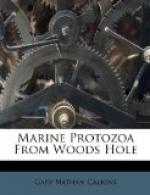The body is ovoid or cylindrical, with well-rounded ends, and in some cases slightly flattened. The mouth is ventral and placed some distance from anterior end (1/4 to 1/3 total length). A slight depression on the ventral surface marks the mouth region, which is further indicated by larger and more powerful cilia. The rest of the body is uniformly ciliated. The entire body is marked by clearly defined spiral stripes. The mouth is circular and the oesophagus is supported by a considerable armature, which usually extends dorsally and to the left, rarely to the right. In some cases the structure of this armature is indistinct; again it can be clearly seen to consist of definite rods (Staebchen). The anus is probably always terminal. Contractile vacuoles are variable in different species. In some cases there is but one, which is placed at the posterior end or centrally on the ventral side; in others there may be four—two dorsal and two ventral. In many cases trichocysts are uniformly distributed. Sometimes the body is colorless; again, and more often, it is brightly colored with red, blue, brown, or black pigment. The macronucleus is globular and central, occasionally band-form and with numerous attached micronuclei. Food substance varied, usually vegetable matter, see, however, below. Cysts are globular. Movement is a steady progression, combined with rolling.
Nassula microstoma Cohn ’66. Fig. 34.
Synonyms: Paramoecium microstomum Cl.
et Lach. ’58, Gourret et
Roeser ’88; Isotricha microstomum Kent
’81.
Body subcylindrical, rounded at each extremity, not quite twice as long as broad. A slight depression on one surface marks the position of the mouth, this depression being indicated by a row of longer cilia. The mouth is extremely small and is surrounded by a curious buccal armature. This is not made up of bars or rods, as in most species of Nassula, but appears perfectly smooth and uniform except for the considerable swelling at the inner end. The cuticle is firm and unyielding and marked by longitudinal and somewhat spiral rows of cilia and trichocysts. Under the microscope this is one of the most pleasing forms found at Woods Hole. Its color is yellowish brown from the presence of brilliant particles of coloring matter held in the cortical plasm, and, as it slowly rolls along, these particles and the black trichocysts give to the organism a peculiar sparkling effect. The macronucleus is almost central; the contractile vacuole posterior. The endoplasm appears well filled with food bodies, some of which could be distinguished as Amphidinium and Glenodinium.
Length 55 mu; greatest diameter 30 mu.
[Illustration: Fig. 34.—Nassula microstoma.]
Genus CHILODON Ehr.
(Dujardin ’41; Engelmann ’78; Stein ’54,
’58; Kent ’81; Buetschli ’88;
Gruber ’83; Cienkowsky ’55; Moebius ’88;
Clap. et Lach ’58;
Wrzesniowksi ’65; Shevyakov ’96.)




